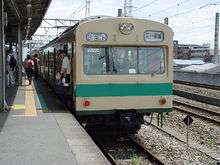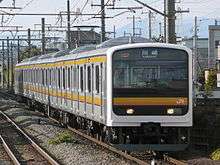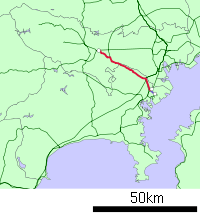Nambu Line
| Nambu Line | |||
|---|---|---|---|
|
| |||
|
A Nambu Line E233-8000 series EMU, October 2014 | |||
| Overview | |||
| Native name | 南武線 | ||
| Type | Commuter rail | ||
| Locale | Tokyo, Kanagawa prefectures | ||
| Termini |
Kawasaki Tachikawa | ||
| Stations | 26 (main line), 3 (branch line) | ||
| Operation | |||
| Opened | 1927 | ||
| Owner | JR East | ||
| Rolling stock | 205 series, 209 series, E233-8000 series | ||
| Technical | |||
| Line length | 45.0 km (28.0 mi) | ||
| Track gauge | 1,067 mm (3 ft 6 in) | ||
| Electrification | 1,500 V DC overhead catenary | ||
| |||
The Nambu Line (南武線 Nanbu-sen) is a Japanese railway line which connects Tachikawa Station in Tachikawa, Tokyo and Kawasaki Station in Kawasaki, Kanagawa. For most of its length, it parallels the Tama River, the natural border between Tokyo and Kanagawa prefectures. It lies along the Tama Hills. It is part of the East Japan Railway Company (JR East) network. The line forms part of what JR East refers to as the "Tokyo Mega Loop" (東京メガループ) around Tokyo, consisting of the Keiyo Line, Musashino Line, Nambu Line, and Yokohama Line.[1] The name refers to the southern (南 nan) part of the ancient province of Musashi (武蔵) (now Tokyo and northern Kanagawa prefectures), through which the Nambu Line runs.
Basic data
- Operators, distances:
- Total: 45.0 km (28.0 mi)
- Passenger: 39.6 km (24.6 mi)
- Freight: 39.4 km (24.5 mi)
- East Japan Railway Company (JR East) (Services and tracks)
- Kawasaki – Tachikawa: 35.5 km (22.1 mi)
- Shitte – Hama-Kawasaki: 4.1 km (2.5 mi)
- Shitte – Shin-Tsurumi Signal Station – Tsurumi: 5.4 km (3.4 mi) (no regular service)
- Japan Freight Railway Company (JR Freight) (Services only)
- Shitte – Tachikawa: 33.8 km (21.0 mi)
- Shitte – Hama-Kawasaki: 4.1 km (2.5 mi)
- Shitte – Shin-Tsurumi Signal Station: 1.5 km (0.9 mi)
- Total: 45.0 km (28.0 mi)
- Stations: 29
- Main line: 26
- Branch line: 3
- Double-tracking: Kawasaki – Tachikawa
- Railway signalling: Automatic Block System
Station list
Main line
"Rapid" service trains (two trains per hour between 10 a.m. and 4 p.m) do not stop at Shitte, Yakō, Hirama, Mukaigawara, Tsudayama, Kuji, Shukugawara, Nakanoshima, or Yanokuchi. All other trains except for some seasonal services are "Local" services, stopping at all stations. From the start of the revised timetable introduced on March 14, 2015, "Rapid" services will no longer stop at Minami-Tama, Nishifu, Yaho, Yagawa, or Nishi-Kunitachi.
Nambu Branch Line
- All stations are located in Kanagawa Prefecture.
- Trains can pass each other only at Kawasaki-Shinmachi.
| Station | Japanese | Distance (km) | Transfers | Location | ||
|---|---|---|---|---|---|---|
| Between stations |
Total | |||||
| Shitte | 尻手 | - | 0.0 | Nambu Line (main line), Nambu Line (freight branch) | Saiwai-ku, Kawasaki | |
| Hatchōnawate | 八丁畷 | 1.1 | 1.1 | Keikyu Main Line Tokaido Main Line freight branch (for Tsurumi) |
Kawasaki-ku, Kawasaki | |
| Kawasaki-Shinmachi | 川崎新町 | 0.9 | 2.0 | |||
| Odasakae | 小田栄 | 0.7 | 2.7 | |||
| Hama-Kawasaki | 浜川崎 | 1.4 | 4.1 | Tsurumi Line, Tokaido Main Line freight branch (for Kawasaki Freight Terminal) | ||
Freight branch
The "Shitte crossover" (尻手短絡線 Shitte-tanraku-sen) connects Shitte Station and Shin-Tsurumi Yard on the Tōkaidō Main Line (Hinkaku Line) and the Musashino Line. Freight trains operating between Tokyo Freight Terminal and northern Japan operate on both branch lines.
Former branches
- Yakō – Kawasaki-Gashi: opened 1927, closed 1972
- Mukaigawara – Shin-Tsurumi Yard: opened 1929, closed 1973
Rolling stock
The fleet of electric multiple unit (EMU) trains used on Nambu Line services is based at Nakahara Depot.[2]
- 209-2200 series 6-car EMUS (since 2010)
- 205-1000 series 2-car EMUs (Nambu Branch Line services, since August 2002)
- E233-8000 series 35 x 6-car EMUs (since 4 October 2014)[3]
- Nambu Line 209-2200 series, April 2011
- Nambu Branch Line 205-1000 series, August 2009
 Nambu Line E233-8000 series, September 2014
Nambu Line E233-8000 series, September 2014
Previously used
- 72/73 series 4/6-car EMUs (from 1963 until 1978)
- 101 series 4/6-car EMUs (from 1969 until January 1991)
- 103 series 6-car EMUs (from 1982 until December 2004)
- 101 series 2-car EMUs (Nambu Branchline services, until November 2003)
- 205-0 series 6-car EMUs from (March 1989 until December 2015)[4]
- 205-1200 series 6-car EMUs (from 2004 until January 2016)
- 209-0 series 6-car EMUs (from April 1993 until February 2015)
 A 73 series EMU on the Nambu Line, January 1975
A 73 series EMU on the Nambu Line, January 1975 Nambu Branch Line 101 series, July 2002
Nambu Branch Line 101 series, July 2002 A Nambu Line 103 series, June 2001
A Nambu Line 103 series, June 2001- Nambu Line 205-0 series set 36 in April 2011
- Nambu Line 205-1200 series, October 2014
 Nambu Line 209-0 series, January 2008
Nambu Line 209-0 series, January 2008
History
The private Nambu Railway opened the line in five stages between 1927 and 1930 (freight branches are omitted):[5]
- March 27, 1927: Kawasaki – Noborito
- November 1, 1927: Noborito – Ōmaru (near Minami-Tama)
- December 11, 1928: Ōmaru – Bubaigawara (then called Yashikibun)
- December 11, 1929: Bubaigawara – Tachikawa
- March 25, 1930: Shitte – Hama-Kawasaki
Passenger trains utilised electric multiple units (EMUs) from the beginning. Freight initially consisted primarily of gravel hauled from the Tama River. When the railway reached Tachikawa and made connection with the Ōme Electric Railway, limestone became one of the main freight commodities. The railway was controlled by Asano zaibatsu, which enabled the transport of limestone from its own quarry in Western Tokyo to its cement plant in Kawasaki without using the government railways.[6]
On April 1, 1944, the railway was nationalised by the imperial government and became the Nambu Line of Japanese Government Railways. After the end of World War II, there were several calls for the privatisation of the line, but the line remained a part of the Japanese National Railways (JNR) until its privatization in 1987.[6]
The postwar growth of the Tokyo urban area resulted in the conversion of most of the farmlands along the Nambu Line into residential areas and increased the passenger traffic on the line. Freight traffic reduced after the opening of the Musashino Line (parallel to the Nambu Line) in 1976 and the discontinuance of the limestone freight in 1998, except for the Nambu Branchline, which remains a major freight route.[6]
Limited-stop "Rapid" services between Kawasaki and Noborito with stops at Musashi-Kosugi and Musashi-Mizonokuchi started on December 15, 1969, but were discontinued by the timetable revision on October 2, 1978.[7] After 33 years, Rapid services between Kawasaki and Tachikawa with more stops started on April 9, 2011, postponed from the originally scheduled March 12 due to the 2011 Tōhoku earthquake and tsunami.[8]
Future developments
Construction of a new station on the Nambu Branch Line is under consideration by JR East in conjunction with the city of Kawasaki. Provisionally named Odasakae-Shin Station (小田栄新駅), the new low-cost station is planned to be built between Kawasaki-Shinmachi and Hama-Kawasaki, with opening scheduled for the end of fiscal year 2015.[9]
See also
References
- ↑ Saka, Masayuki (August 2014). 東京メガループ 車両・路線の沿革と現況 [Tokyo Megaloop: History and current situation of trains and line]. Tetsudō Daiya Jōhō Magazine (in Japanese). Vol. 43 no. 364. Japan: Kōtsū Shimbun. pp. 28–39.
- ↑ JR電車編成表 2013夏 [JR EMU Formations - Summer 2013]. Japan: Kotsu Shimbunsha. May 2013. pp. 91–93. ISBN 978-4-330-37313-3.
- ↑ "E233系8000番台が営業運転を開始" [E233-8000 series enters revenue service]. Japan Railfan Magazine Online (in Japanese). Japan: Koyusha Co., Ltd. 5 October 2014. Retrieved 8 October 2014.
- ↑ 205系ナハ39編成が国府津車両センターへ [205 series set 39 moved to Kozu Depot]. Japan Railfan Magazine Online (in Japanese). Japan: Koyusha Co., Ltd. 10 December 2015. Retrieved 11 December 2015.
- ↑ Ishino, Tetsu et al. (eds.) (1998). 停車場変遷大事典 国鉄・JR編 [Station Transition Directory - JNR/JR] (in Japanese). II. Tokyo: JTB Corporation. pp. 65–69. ISBN 4533029809.
- 1 2 3 Harada, Katsumasa (1999). Nanbu-sen Ima Mukashi (in Japanese). Kawasaki: Tamagawa Shinbunsha. ISBN 4-924882-28-3.
- ↑ 南武線に33年ぶりの「快速」 (in Japanese). Town News. October 1, 2010. Retrieved April 9, 2011.
- ↑ "JR南武線快速ようやく運行スタート、旧国鉄時代以来33年ぶり". Kanagawa Shinbun. April 9, 2011. Retrieved April 9, 2011.
- ↑ 南武支線に新駅設置を検討 [New station under consideration for Nambu Branch Line]. Tetsudo Hobidas (in Japanese). Japan: Neko Publishing Co., Ltd. 29 January 2015. Retrieved 30 January 2015.
External links
| Wikimedia Commons has media related to Nambu Line. |
- Stations of the Nambu Line (JR East) (Japanese)

.svg.png)